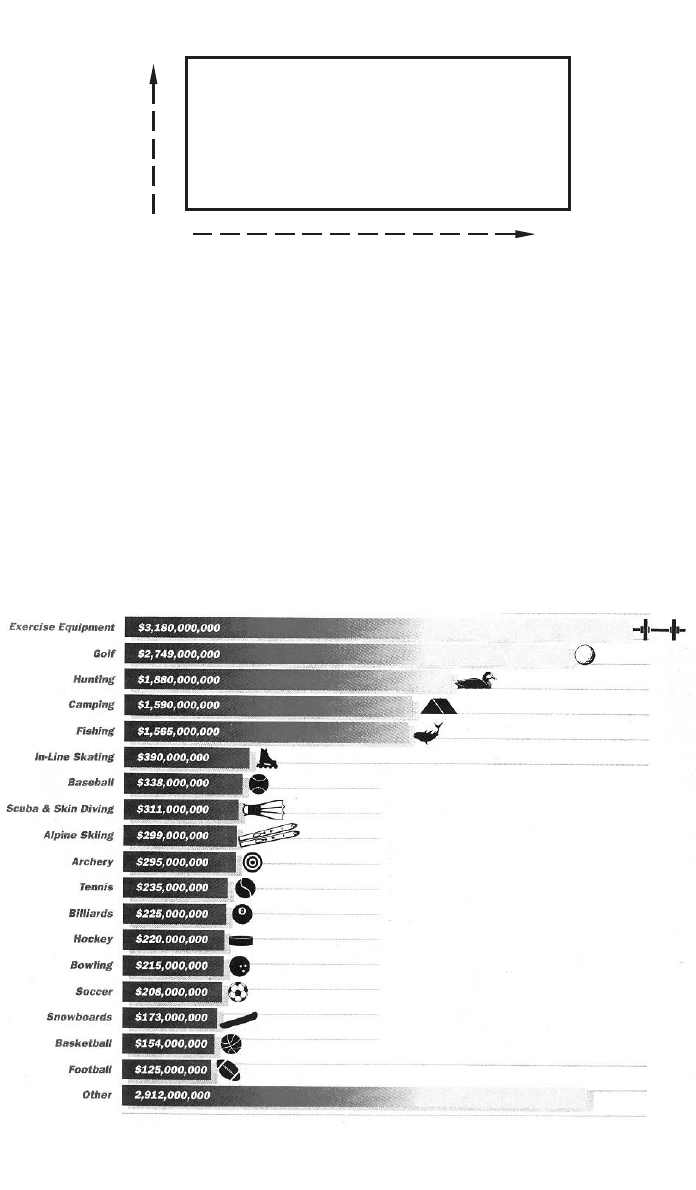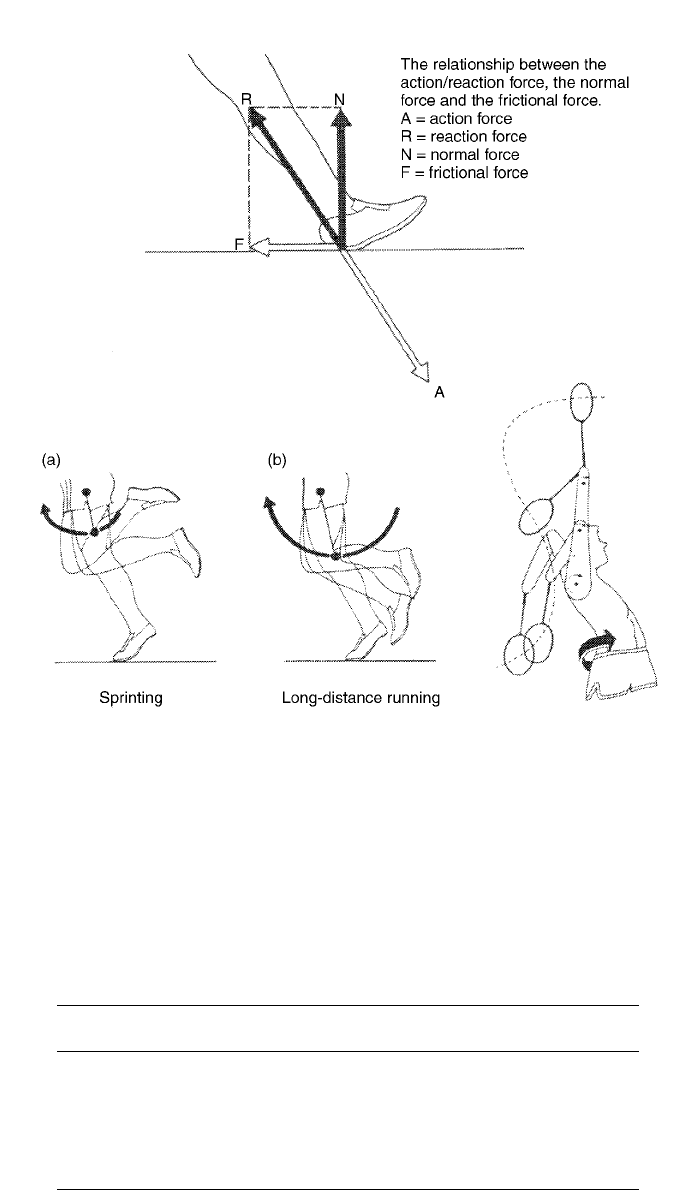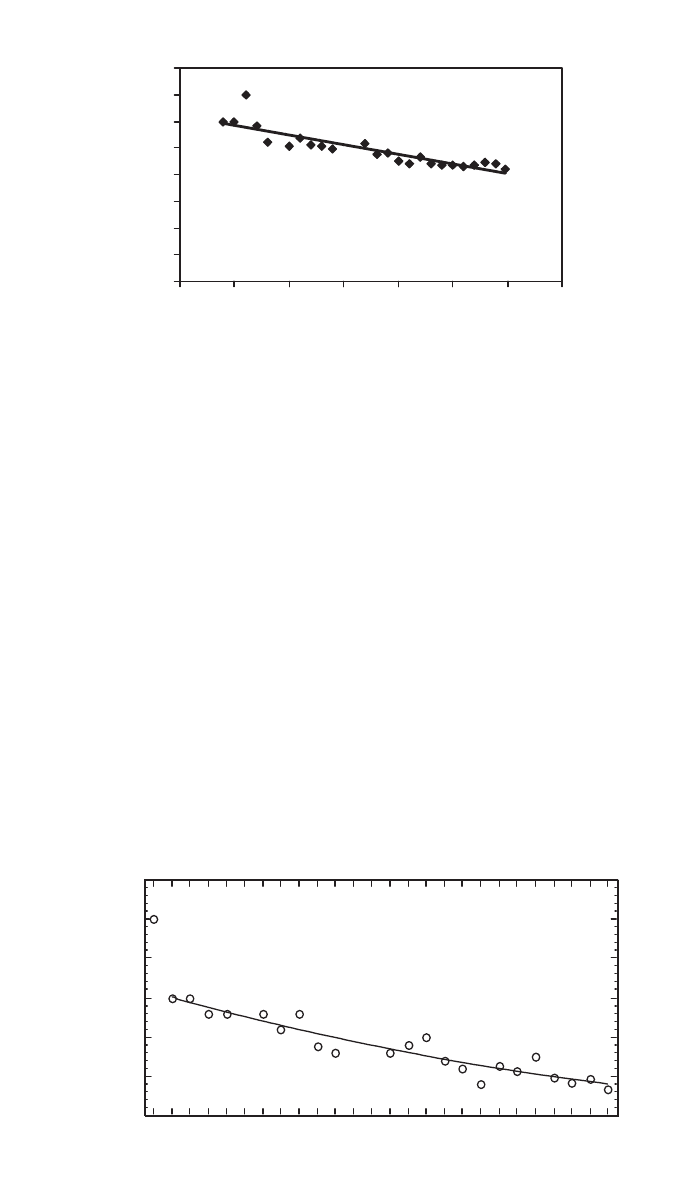Kutz M. Handbook of materials selection
Подождите немного. Документ загружается.


6 CANDIDATE MATERIALS 1249
natively, if the presence of acetic acid on a component is a problem and ethyl
alcohol may be tolerated, use of an RTV that does not exude acetic acid may
be used in the design.
Elastomers
Elastomers
4
are substances, such as natural rubber and polymers, that have ma-
terial properties that resemble rubber.
2,12
These substances have the ability to
return rapidly nearly to their original shape after sustaining substantial defor-
mation due to the application of mechanical stress and the release of that stress.
The properties of elastomers are employed as sealing gaskets and drive belts
and find other uses that involve bending and recovery of shape.
Sometimes used for gaskets and powertrain or drive belts, elastomers are
much more vulnerable to aging and environmental degradation than other plastic
materials and must be selected with care. The designer is cautioned to consider
material properties such as compression set, creep, loss of elasticity, fatigue
failure due to repetitive load, loss of elasticity at low temperatures, strength at
elevated temperatures, tear resistance, and tensile strength that may be degraded
by exposure to ultraviolet and ionizing radiation, elevated temperatures, exposure
to some lubricants and chemicals, and continuous mechanical stress.
6.4 Ceramics and Glasses
Ceramics and glasses are used in similar ways in electronic packaging applica-
tions.
2
They have unique chemical, thermal, and mechanical properties. Both are
primarily used as electrical insulators; however, glasses find a wider range of
use to include substrates, capacitor and resistor bonding components, equipment
and component enclosure seals, and similar uses.
Ceramics
Electronic ceramic materials include electrical porcelains, which have varied
properties based on the amount of aluminum oxide incorporated into the mate-
rial. Aluminum oxide is the additive of choice for ceramic materials for it im-
proves mechanical strength, greatly improves thermal conductivity, and improves
flexure strength. A concern, however, is that the use of aluminum oxide sub-
stantially increases the material coefficient of thermal expansion (about double
that of silicon) and elevation of the material dielectric constant. Ceramics are
often bonded to metal substrates to perform useful electronic functions.
Other oxides may be used such as beryllium (which is toxic) to achieve high
thermal conductivity, aluminum nitride (which also has a high thermal conduc-
tivity) with thermal expansion nearly that of silicon, and boron nitride (which
combines high thermal conductivity with machinability) in a softer yet durable
material.
Glass
Glass is an amorphous noncrystalline material that may be heated, even to a
liquid phase, and formed into useful shapes. Glass performs like a liquid that
has been sufficiently cooled to become substantially stiff and rigid. The inclu-
sions of additives can substantially alter glass melting point, thermal expansion,

1250 MATERIALS IN ELECTRONIC PACKAGING
and electrical properties. Glass may be optically clear, fused with other materials
to make resistors and capacitor elements, and is vulnerable to impact mechanical
loads and thermal shock loads that cause glass to exhibit brittle fracture.
Soda-lime glasses are used to seal hermetic packages and to form insulator
bushing for feed-through devices.
Borosilicate glasses have excellent resistance to chemicals, high electrical
resistance and low dielectric constants, and are used as binders for compounds
associated with component construction.
Lead alkali borosilicate glasses have a lower melting point and are used for
adhesive and sealing applications, including semiconductor processing.
Glass ceramics are machinable materials that may have strength twice that of
ordinary silicon dioxide glasses. They have a crystalline structure with temper-
ature stability lower than that of other glasses and may be shaped into a variety
of useful configurations.
6.5 Adhesives
Adhesives are materials that by adhesion, cohesion, or molecular bonding cling
to the surface of another material. Adhesive materials used for electronic appli-
cations are most often derived from elastomers and plastic polymers. Glasses
are used to perform adhesive functions when the properties of elastomers and
plastics have inadequate temperature range or are insufficiently inert to the prod-
uct environment. Lead–tin solders are used as conductive adhesives in the ap-
plication of surface-mounted parts to printed circuit boards.
Adhesives are utilized for structural bonding, to seal enclosures, to bond and
protect components from the environment, to seal mechanical joints and thus
prevent galvanic corrosion, to join parts for less cost than with mechanical
means, and to join materials where the temperatures developed by processes
such as brazing or soldering would degrade the bonded elements.
The success of an adhesive application is at least as dependent upon proper
joint design and application procedures as it is on the selection of a specific
adhesive material.
The primary requirements for achieving a successful adhesive joint include:
●
The area of the adhesive overlap must be adequate to withstand the me-
chanical loads imposed in service.
●
The mechanical loading generally should not provide peel or cleavage
stresses on the adhesive joint.
●
The adhesive must be able to wet and bond to the substrate material to
which it is applied.
●
The surfaces to be joined must be chemically clean and may require a
properly applied primer.
●
If the adhesive mixture consists of multiple components, these compo-
nents must be accurately measured and properly mixed.
●
Pressure, elevated temperatures, and positioning fixtures may be needed
during cure of the adhesive.

REFERENCES 1251
Table 5 Adhesives Used in Electronic Packaging
Thermosetting Thermoplastic Elastomeric Hybrid
Cyanoacrylate Polyvinyl acetate Butyl Epoxy phenolic
Polyester Polyvinyl acetal Styrene butadiene Epoxy polysulfide
Epoxy Polyamide Phenolic Neoprene
Phenolic Acrylic Polysulfide Vinyl phenolic
Polyimide Silicone
Neoprene
●
The cure cycle may require several hours for the adhesive to gain full
strength.
●
The adhesive material must withstand processing and usage environmental
temperatures and chemicals.
There are three categories of adhesive materials:
1. Structural Adhesives intended to hold two or more parts together under
conditions where the adhesive joint is subjected to high mechanical loads
2. Holding Adhesives intended to permanently or on a temporary basis
hold lightweight items in place
3. Sealing Adhesives intended to fill a space between two or more mate-
rials and provide a seal without the need to have high structural strength
There are a wide variety of materials utilized as adhesives that include at least
the adhesives identified by Table 5.
7 SUMMARY
The key to successful materials selection is the ability to identify the set of
materials most likely to offer a design solution and then to correctly select and
employ one or more materials from that set to provide the optimum result. This
involves the careful definition of the dominant technical functions that the ma-
terial must perform including compliance with an overriding set of considera-
tions. A review of the use of materials in successful design applications is also
a useful guide to materials selection. Within these constraints, the total cost of
use [basic materials cost, material preparation (machining, molding, forming,
joining, finishing, assembly, packaging, handling, protection, service limitations,
other) and customer support issues] may be determined or estimated. Each of
the remaining materials selection options may then be compared, thus leading
to identification of the most economical and suitable choice of material for the
application.
REFERENCES
1. W. T. Shugg, Handbook of Electrical and Electronic Insulating Materials, Van Nostrand Rein-
hold, New York, 1986.
2. B. S. Matisoff, Handbook of Electronics Packaging, Van Nostrand Reinhold, New York, 1982.
3. Part 15, Federal Communications Rules and Regulations, www.fcc.gov.

1252 MATERIALS IN ELECTRONIC PACKAGING
4. M. Kutz, Mechanical Engineers Handbook, Wiley, New York, 1998.
5. D. G. Fink, Electronic Engineers’ Handbook, McGraw-Hill, New York, 1975.
6. Alloy Cross Index, Mechanical Properties Data Center, Battelle’s Columbus Laboratories, Colum-
bus, OH, 1981.
7. Metals Handbook, American Society for Metals, Metals Park, OH, 1998.
8. Stainless Steel Handbook, Allegheny Ludlum Steel Corporation, Pittsburgh, 1956.
9. Aluminum and Aluminum Alloys, American Society for Metals, Metals Park, OH.
10. www.Pb-Free.com, an interactive website dedicated to providing information regarding lead-free
soldering.
11. C. A. Harper, Handbook of Plastics and Elastomers, McGraw-Hill, New York, 81.
12. M. Morton, Rubber Technology, Van Nostrand Reinhold, New York, 1987.

1253
CHAPTER 40
ADVANCED MATERIALS IN SPORTS
EQUIPMENT
F. H. Froes
Institute for Materials and Advanced Processes (IMAP)
University of Idaho
Moscow, Idaho
1 INTRODUCTION 1253
2 CHARACTERISTICS OF
MATERIALS OF IMPORTANCE
IN SPORTS EQUIPMENT
DESIGN 1255
3 THE IMPACT OF ADVANCED
MATERIALS ON SPORTS
PERFORMANCE 1257
3.1 Running 1257
3.2 Pole Vaulting 1259
3.3 Bicycling 1260
3.4 Tennis and Squash 1263
3.5 Cricket 1264
3.6 Golf 1264
3.7 Baseball/ Softball 1266
3.8 Boats, Boards, and Wind-
Surfing Fins 1267
3.9 Javelin 1269
3.10 Skiing and Boards 1270
3.11 Hockey Equipment 1270
4 ETHICAL CONSIDERATIONS 1270
5 CONCLUDING REMARKS 1272
REFERENCES 1273
1 INTRODUCTION
Advanced materials can significantly enhance sports performance and dramati-
cally tilt the playing field. This paper discusses the use of advanced materials
in sports and suggests that there are ethical questions surrounding their use.
Advanced materials with mechanical and physical behavior characteristics
well in excess of those exhibited by conventional high-volume materials such
as steels and aluminum alloys have contributed significantly to the increased
performance of transportation systems in aerospace, automobiles, and rolling
stock (trains). The important characteristics include strength, ductility, stiffness
(modulus), temperature capability, forgiveness (a collective term including frac-
ture toughness, fatigue crack growth rate, etc.), and low density. For many high-
performance applications high cost can be accepted, although the level of
acceptance depends upon the industry in question (Fig. 1).
In this chapter the role of advanced materials in a number of sporting events
will be addressed. At the highest professional level sports are a highly compet-
itive occupation with millions of dollars depending upon fractions of a second
or tenths of an inch. Even the dedicated amateur is willing to invest a great deal
of money to improve performance, even though this may occur as infrequently
HandbookofMaterialsSelection.EditedbyMyerKutz
Copyright Ó 2002 John Wiley & Sons, Inc., NewYork.

1254 ADVANCED MATERIALS IN SPORTS EQUIPMENT
• Construction
• Automotive
• Commercial Aerospace
• Military Aerospace
• Biomedical
Emphasis on cost
Emphasis on performance
Fig. 1 Impact of cost in various industries.
Fig. 2 Graph showing how industries in advanced materials lead to
enhanced performance, and a $17-billion sporting equipment market in the
United States in 1997 says the buying public agrees.
as once a month. Thus, just as in the industries mentioned earlier, if advanced
materials lead to enhanced performance, their use can be justified; and a $17
billion sporting equipment market in the United States in 1997 says the buying
public agrees (Fig. 2). The characteristics of advanced materials that lend them-
selves to this enhanced sporting behavior parallel those listed for other industries
above.
Just as in the transportation industry the materials of choice for sports have
shown a major evolution over the last 100 years. From naturally occurring ma-
terials such as wood, twine, gut, and rubber we have progressed to high-

2 CHARACTERISTICS OF MATERIALS OF IMPORTANCE 1255
technology metals, polymers, ceramics, and synthetic hybrid materials, including
composites and cellular concepts.
In this chapter consideration is first given to a broad discussion of the me-
chanical properties of materials that are significant in sporting equipment. Then
there is a more detailed examination of how advanced materials have impacted
various specific sports. Here an attempt has been made to define how measurable
(absolute) records have been influenced by these advanced materials. I have
attempted to subtract the portion of these improvements that are a result of
improvements in the capability of the human body, whether this be a conse-
quence of enhanced body function derived from superior training, diet, or will
power. Advanced materials have led to substantial improvement in some sports,
much less in others. In addition, advanced materials have not only led to im-
provements in performance for the paraplegic athlete, but in some cases partic-
ipation would not have been even possible without them. Finally, there is a
discussion of the ethics of the use of advanced materials in the sporting arena.
The term technological momentum
1
—once technological choices are made
(or ‘‘allowed’’) and implemented, reversing the decision becomes difficult—
exists for sporting equipment. This is particularly the case when athletes and
manufacturers have a great deal invested in the new technology. Once a sports
organization makes a technological choice, it is often a permanent decision.
2 CHARACTERISTICS OF MATERIALS OF IMPORTANCE IN SPORTS
EQUIPMENT DESIGN
The optimum design of sports equipment requires the application of a number
of disciplines not only for the enhanced performance already mentioned but also
to make the equipment as ‘‘user friendly’’ as possible from the standpoint of the
avoidance of injuries.
2
Clearly sports equipment design encompasses materials
science, mechanical engineering, and physics; however, it also necessitates a
knowledge of anatomy, physiology, and biomechanics. Biomechanics can be
simply defined as the science of how the body reacts to internal and external
forces.
3
It is thus an attempt to apply the basic laws of physics and mechanics
to the joints, ligaments, and tissues of the body as they are subjected to loading
(Fig. 3).
In designing sports equipment, various characteristics of materials must be
considered
4,5
:
●
Strength
●
Density
●
Ductility
●
Fatigue resistance
●
Toughness
●
Modulus (damping)
●
Cost
To meet the requirements of sports equipment, the materials of choice often
consist of a mixture of material types, metals, ceramics, polymers, and composite
concepts. They are fabricated into the desired equipment making use of creative

1256 ADVANCED MATERIALS IN SPORTS EQUIPMENT
Fig. 3 Biomechanics of sports addresses the analysis of forces and stresses
which act on the body in various sports. (From Ref. 2.)
Table 1 Typical Mechanical Properties of Material Classes
Materials Classes
Young’s Modulus
E (MPa) ⫻ 10
3
Density
(mg m
⫺3
) E /
⫻ 10
3
Metals 40–210 2–8 24–30
Glass 73
⬃2.5 ⬃30
Ceramics 400–700
⬃3.5 100–230
Fibers (B,C)
⬃400 ⬃2.4 ⬃170
Carbon fiber composite 200 2.0 100
Wood 14 0.5 28
design concepts with due attention being given to biomechanical requirements.
By comparing specific properties (i.e., taking the difference in density of com-
peting materials into account), the attributes of different materials can be better
evaluated (Table 1). If we want a material that features the highest possible
stiffness for the least possible weight, we would select the materials with the

3 THE IMPACT OF ADVANCED MATERIALS ON SPORTS PERFORMANCE 1257
Fig. 4 Parts of a running shoe. (From Ref. 2.)
highest specific stiffness. Cellular concepts win out compared to monolithic ma-
terials in this regard because the density of cellular materials are less than those
of solid articles. In the actual design of complex sports equipment, a specific
design criterion needs to be defined to allow the optimum materials selection to
be made.
3 THE IMPACT OF ADVANCED MATERIALS ON SPORTS
PERFORMANCE
To illustrate how advanced materials have impacted sports performance a num-
ber of sporting events will be considered in which a contribution to the improved
performance can be attributed to the materials used to construct equipment.
Wherever possible, measurable quantities (distance, time) of improvements in
performance will be given.
6
3.1 Running
Shoes have provided substantial improvements in the running events. The human
feet are very complex biomechanical structures that are highly prone to stress
and injury.
2
Thus, a running shoe needs to be complex and consists of a variety
of different materials (Fig. 4),
6
which are selected according to their resilience,
strength, elasticity (stretchability), compression, durability, and wear resistance.
About 80% of runners hit the ground on the center heel, roll onto the midfoot,
and finally push off with the ball of the foot.
2
The midsole is key in providing
cushioning during impact with the ground. Usually, it is made from a plastic
foam that in some concepts includes ‘‘air pockets’’ (Air Max) filled with pres-
surized gas. However, these cushioning effects break down with use (even after
only 100 km of running) with reduced cushioning efficiency. For the future,
better cushioning systems are likely with increased tailoring to the individual (if
you can afford it).

1258 ADVANCED MATERIALS IN SPORTS EQUIPMENT
0
0.5
1
1.5
2
2.5
3
3.5
4
1880 1900 1920 1940 1960 1980 2000 2020
Years
Marathon Record Time (hrs)
Fig. 5 Improvement in Olympic records for the men’s marathon in the past 100 years.
9.5
10.0
10.5
11.0
11.5
12.0
12.5
Winning time in 100m sprint (s)
1896
1900
1904
1908
1912
1916
1920
1924
1928
1932
1936
1940
1944
1948
1952
1956
1960
1964
1968
1972
1976
1980
1984
1988
1992
1996
Fig. 6 Winning times for the 100-m sprint at the Olympic Games since 1896.
This author contends that the improvements summarized above have been
much more in the comfort/avoidance of injury arena than in absolute perform-
ance enhancement. In 1896 in the first modern-day Olympics when Spiridon
Loues won the marathon (which was actually somewhat shorter in distance than
it is today), for all of Greece to celebrate with him, he barely broke 3 h (Fig.
5). Almost 100 years later the Olympic marathon record is a little over 2 h,
about a 30% improvement. The majority of this improvement can be attributed
to an improvement in human performance. The same can be said for the 100-
m event (Fig. 6).
If we turn our attention to the paralympics, a totally different situation exists.
There were no Olympic Games in 1896 for those requiring prosthetic limbs.
The paraplegic could hardly move, never mind compete in athletic competition.
But by 1992 the paraplegic could not only compete, but he could also outperform
the majority of us who have use of all our limbs.
Paraplegic Joe Gaetani broke world records in both the 100-m and 200-m
sprint events in Barcelona (Table 2). He made use of the amazing Springlite II
